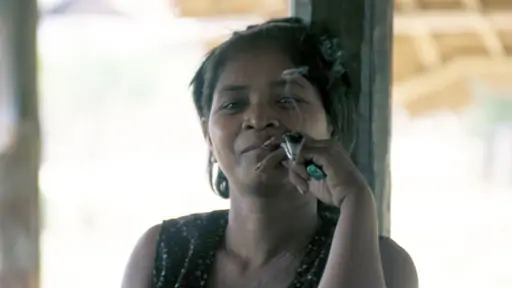Indigenous Calendar July, 2010: Kavet Gender Discrimination, Cambodia

Southeast Asia is a region — to most western observers — of gender discrimination and most commonly against females. This gender discrimination is observed in both indigenous and non-indigenous societies. One form it takes is in the social acceptance of smoking. A large percentage of males smoke in Southeast Asia, yet smoking among females (at least in public) is generally frowned upon.
In northeastern Cambodia the indigenous population is still largely isolated from many of the social norms of outside society. So it is still widely considered equally acceptable for males and females to smoke. Even children are sometimes seen smoking in public in many indigenous communities there — in fact probably more so among girl children — although this is gradually becoming less practiced and less socially acceptable.
During a visit to a very remote Kavet community in this area of Cambodia I had asked my guide to stop because there was an assembly of people and I was interested in knowing the reason for their gathering. I soon learned that it was a meeting of community elders to discuss the merits of a land sale transaction. I was surprised to see a large presence of women and I asked if they were there to be a part of the decision making. My question was met with confusion and the answer — equally to my surprise — was "of course!"
My third surprise was at how easily this Kavet community accepted my continued presence after my questions had been answered. I observed the proceedings with a keen eye but not yet with my camera. Even though I don't speak or understand the Kavet language, I could discern a lot from body language and tone of voice. Most of the men, but none of the women or children I'd seen, were smoking. Then something happened. (My guide could not find the English to explain it but I was sure that consensus had been reached on a major point of the meeting.) Some of the women began smoking. Again my guide could not find the English to explain it, but I felt certain that this was also a form of gender discrimination — that smoking among the women had now been sanctioned because of the consensus that had been reached.
Of course, my interpretation of events could be completely incorrect; my method was informal and unscientific. I had a feeling that now would be the best time to ask for one of the women's permission to take a portrait photograph of her smoking. In all the indigenous communities in this area of Cambodia that I'd previously visited and asked permission to take this kind of photograph the answer had been "no." The first woman I asked agreed to my request.
The Kavet are featured in our documentary, Indigenous Peoples of Southeast Asia.
If you enjoyed reading this article, please consider supporting independent, advertising-free journalism by buying us a coffee to help us cover the cost of hosting our web site. Please click on the link or scan the QR code. Thanks!


